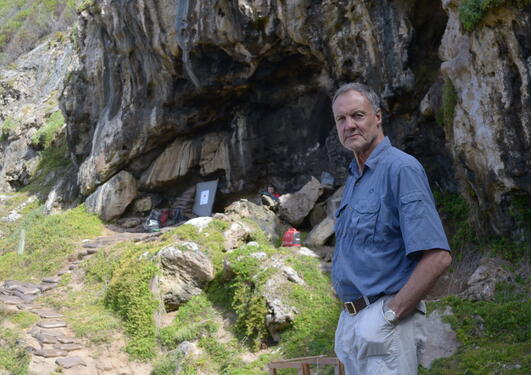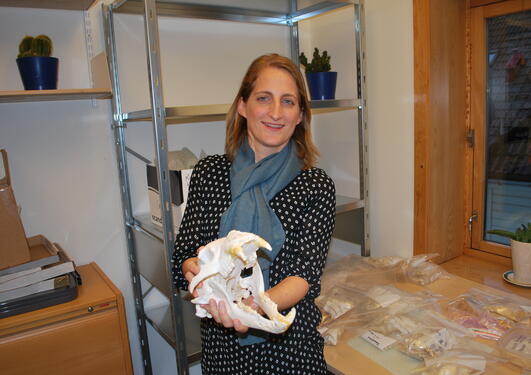Goldsmith turned archaeologist
UiB researcher Karen van Niekerk's road to (a Centre of) excellence.

Main content
– After school I studied jewellery design and manufacture and worked as a goldsmith for 5 years. While this satisfied my creative side, I felt that my inquisitive nature was not being fulfilled, so I started looking around for other opportunities, opens Karen Loise van Niekerk, archaeologist and researcher at the Department of Archaeology, History, Cultural Studies and Religion at the University of Bergen (UiB).
Born and raised on a farm just outside of Cape Town, South Africa, van Niekerk's road to academia was a winding, but interesting one.
– As luck would have it, I managed to get a research assistant position at the IZIKO Natural History Museum in Cape Town sorting material from a Middle Stone Age site called Blombos Cave. Initial sorting consisted of basic separation of various materials (stone, bone, shell etc.). It was a bit tedious at times, but there was always the possibility of finding something special that the excavators missed, which did happen from time to time, she assures us.
Fish bones
The now accomplished archaeologist then moved from just sorting the findings to also analyzing them.
– I later progressed to shellfish analysis and assisting in excavations at Blombos. I also started taking part-time archaeology classes at the University of Cape Town (UCT) during that time. I completed my Honours degree at UCT in 2002.
Now heavily involved in the new Centre of Excellence (CoE) at the Department of Archaeology, History, Cultural Studies and Religion at UiB, titled SapienCE - Centre for Early Sapiens Behaviour, she first came to Norway to attain an M.Phil degree, which was completed in 2005. Six years later, van Niekerk obtained her PhD from UCT. In both her theses for these degrees she focused on the research of fish bones.
– For my PhD thesis I developed a methodology for identifying archaeological fish bones to species in a way that is more accurate and less time-consuming. It was based on the analyses of 41210 fish bones from four Later Stone Age and two Middle Stone Age sites in the southern Cape.
Blombos
Throughout both her under- and post-graduate studies, van Niekerk worked for the Blombos Project. The project entails excavation of the Blombos Cave in Blombosfontein Nature Reserve, South Africa, which has been ongoing since 1991, and has been extended to include sites in the De Hoop Nature Reserve since 2010. These sites serve as the basis for the aforementioned CoE, which is spearheaded by UiB Professor Christopher Henshilwood.
– During my graduate studies we also ran field schools for mostly Norwegian master students at De Hoop Nature Reserve, teaching them excavation and analysis skills. I met very many wonderful Norwegians in those years.
Many of these she met up with again, when she was hired at UiB in 2010 to work as a researcher on the ERC funded Tracsymbols project at the Department of Archaeology, History, Cultural Studies and Religion.
That project ended in 2015, but as of February this year van Niekerk has been appointed at UiB as a researcher in African Middle Stone Age archaeology, and also as a Principle Investigator (PI) in ‘SapienCE - Centre for Early Sapiens Behaviour’, within the CoE that was recently granted to Professor Henshilwood by the Research Council of Norway.
After a lengthy application process and months of planning after being granted the new centre, she is now looking forward to getting going with the research.
– I'm really looking forward to the upcoming collaboration with fellow CoE PI Carin Andersson Dahl from Uni Research on shellfish from our Middle Stone Age sites. One aspect will be using isotopic analyses of shellfish to reconstruct sea surface temperatures, which in turn will tell us during which seasons people were living in the sites along the coast.
– This is something that has not yet been resolved for the Middle Stone Age. We know very little about how people used the landscape then, and whether their movements were governed by the seasons, van Niekerk explains.
Best advice
The urge to uncover new knowledge is something which has stayed with her since she first started out as a student.
– Initially, the sense of excitement at all the information that I could gather and follow up on in the university library – one paper leading to another and yet another – was great for satisfying my curiosity, and still is.
Her best memories from that time was the field trips, which she remembers fondly.
– Living and working in the bush in the middle of nowhere can bring out the best and the worst in all of us, van Niekerk says and smiles, before adding:
– And I distinctly remember the day that I was finally allowed to actually excavate at Blombos Cave!
When asked about the best piece of advice she can give students today, the archaeologist doesn't hesitate:
– I would recommend that students look for and grab every single opportunity they can get to expose themselves to as many aspects of archaeology as they possibly can, in order to find the field that they find most interesting and that they would like to pursue further. These could be in the form of volunteering on digs, at museums, or taking some short intensive workshops/classes on various topics. There are so many ways of broadening your knowledge, that it would be a real pity not to make use of the opportunities available.
– Look around and see what is available and go for it. It might cost a bit of money, or it might interfere with your holiday plans, but these experiences are priceless, and will stay with you forever. Once you are employed, it is unlikely that you will ever have the time to go on these adventures, so make the most of it while you can!

